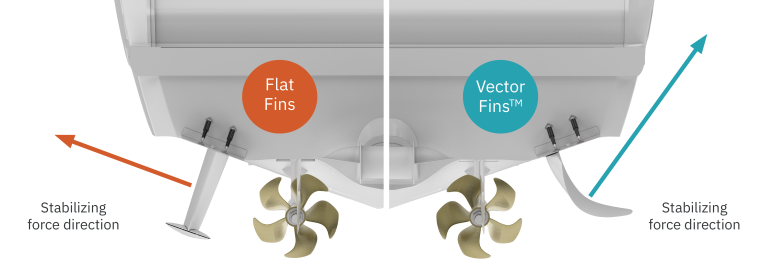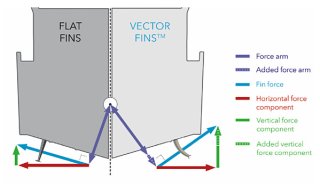If you’re considering installing fin stabilizers on your boat, you’ve probably discovered there are two options for the shape of the fin: curved Vector fins from Side-power and traditional flat fins offered by a number of different suppliers including ABT, Wesmar, Naiad & Humphree, among others. While functionally similar, the two different styles produce very different results, and any one of them may be a good fit for your boat and provide a better ride with improved stability. Imtra stabilizer expert Prentice Weathers explains the key differences:
What advantages do straight fins have over Vector Fins?
Originally developed for ocean liners more than 80 years ago, flat fins have been around for a long time, and have provided good roll reduction on boats for decades. The main advantage to a flat-fin stabilizer system is that they typically cost roughly 10% less than a Vector fin system, including installation. However, It’s hard to be precise about the exact cost difference because each individual installation is unique, and the labor involved is a big factor when adding any stabilizing fins.
What advantages do the curved Vector Fins have over straight fins?
The essential advantage of Vector fins is in their curvature, which directs the fin’s stabilizing force more vertically than a flat fin would. Think of a dinghy next to a dock and what happens when a wave comes along. Naturally, the boat rolls, but you can stabilize it quickly by pushing down vertically on the rail. All fin stabilizers create a similar force, but from underneath the boat instead.
The big difference is that the force from fins isn’t vertical. The force is parallel to the angle of the boat’s bottom (called the “deadrise”), plus whatever the roll angle of the boat is caused by the wave. For example, if the deadrise angle is 22 degrees, and the wave causes 6 degrees of boat roll, the force from the fin will be angled about 28 degrees—nothing like the 90 degrees you use when pushing down on the rail. So instead of a purely vertical force, it has much more horizontal direction.

Because the Vector fins curve outwards, the net force they generate is significantly more vertical—much closer to an average of 62 degrees compared to 28 for flat fins—creating an anti-roll force that is typically about 50% more efficient that that of straight fins (see diagram above) As a result of this geometry, curved-fin stabilizers have a huge advantage in effectiveness at all times over straight fins because they generate much more vertical force. Size for size, the curved fins will reduce roll much more than flat fins. Depending on deadrise angle, it could be 20% to 30% more—with greater differences noted on boats with flatter (lower-deadrise) bottoms.
Another advantage Vector fins have is they enhance the overall performance of the boat due to the shape & efficiency of the design. Most flat fins are symmetrical with a fatter cross-sectional NACA foil shape than the Vector fins, while Vector fins are thinner in section, and slightly asymmetric. If you look at a Vector fin from the side, in profile view, and see the shape of the fin, you’ll see it is curved from the top to the bottom—a complex, slippery form, compared to a straight fin. The fin also sweeps aft from top to bottom and carries small winglets, which are subtle and quite effective at reducing turbulence and its associated drag. Due to their efficiency, Vector fins are also typically smaller than their straight counterparts. These factors all add up to increased speed for a boat with Vector fins.
The increased speed also means improved fuel efficiency. The curved shape of Vector fins creates lift, that slightly raises the hull out of the water, reducing surface area on the water creating drag. The fin itself creates minimal drag and much less resistance than a flat fin. There is little to no loss of speed relative to a boat with no fins at all, whereas straight fins create more drag and less lift than a curved fin, which together slow the boat down.
Which style of stabilizer fin is better at anchor?
Any fin stabilizer system, be it flat or curved, is not quite as good as a gyroscopic stabilizer system when it comes to at-rest stabilization. But comparing fins to fins, there are several ways in which Vector fin stabilization systems out-perform flat-fin systems.
First, the actuators used by Side-Power on Vector Fin stabilizers are all dual-cylinder, so they produce the same amount of force in both directions. Many manufacturers have single-cylinder actuators, which are less effective because they generate about 50% less force in one direction than the other, which isn’t an issue underway but reduces the effectiveness of at-rest stabilization.

Boats with Vector fins also have less of a tendency to “swim” at anchor. Any boat with fins that is moored or anchored in light winds will naturally “scull,” working forward towards its mooring. Vector fins scull less due to their curvature, which converts more of the applied energy into vertical force rather than horizontal. Side-Power also built in the ability to disable one fin while at anchor with the touch of a button. This reduces the swimming effect by over 50%. Humphree electric stabilizers are the only flat-fins that have eliminated the swimming issue.
How does the cost of Vector Fins compare to standard straight fins?
Comparing one system to another includes comparing overall equipment and installation costs. If the builder is installing a Vector Fin stabilizer system during the construction of a new boat or offering it as an option, they typically aren’t also offering the option of flat fins, so it’s hard to make a comparison. In a refit situation, a hydraulic flat fin system will cost less for the equipment, typically, but about the same for installation, so overall, they are pretty similar. On the other hand, the equipment cost for an electric stabilizer system is typically 30% higher than hydraulic. All electric stabilizers use flat fins due to the fact that the curved fins are patented by Side-Power, so electric flat fins systems are actually more expensive than the curved Side-Power hydraulic fin system.
Final Considerations
When we look at the focus boat builders put on stabilizers now, the success of modern gyros, the introduction of curved fins, and the recent development of electric actuators, it’s certainly clear that innovation and creativity are alive and well in the stabilizer business.
No system will be perfect, and all will involve considerable expense. For boat owners/buyers, it’s really important to understand how he or she will use the boat (typical sea conditions, cruising speed, distances, etc.), understand the advantages and differences between systems, and make a judgement as to which system will check the most boxes. For a comparison of fin systems to gyros, check out this article: Fins vs. Gyros: What You Need to Know About Boat Stabilizers